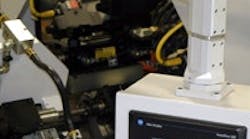The beginnings of Lomar Machine & Tool (www.lomar.com) reach back to 1976, when the founder and current CEO left an engineering position with an hydraulic fitting manufacturer/distributor to start a job shop. From that start, with a few family members, the company developed an international presence through the design and build of processing equipment. Lomar serves the automotive, aerospace, agriculture, alternative energy, food processing, medical, industrial, hydraulic, military and furniture industries, but specializes in a wide range of plumbing processing equipment that does tube-end-form, tube-bend, assembly and brazing, hose-to-tube crimping and a full line of leak test equipment.
Those machine design and build experiences evolved to building qualified turnkey systems and a machine integration business that is ISO-certified.
“Traditionally the automotive industry required machines dedicated to a single product line with a capacity to produce more than a million pieces per year,” explains Ron Geisman, president of Lomar. “The additional industries that we currently work with have a greater need for flexibility—the capability to run a number of different part configurations through a single machine. All the industries we serve require rigidity, reliability and process capability in the machines we build.”
Lomar has built its reputation on tube-fabricating equipment, but the ever-changing industrial trends caused it to branch its machine-building capabilities and product lines outside of the tube-fabricating industry. “Typical machine builds include our standard line of end-forming equipment and crimp/press machines,” says Geisman. “We build leak test units, assembly machines, welding and brazing operations, bending equipment in addition to de-gating machinery and sonic-weld systems for the plastics industry. Complexity of the systems varies based on the customer specifications. Stand-alone units and turnkey systems, as well as both hard and robotic integration into existing machine cells, are common projects.”
PLCs, touch panels and servo-driven units comprise the critical foundation of Lomar’s machines. “The majority of our customers continue to require PLC-based controls,” explains Art Krallman, controls engineer. “At this point, we use a limited number of embedded controls. Everything is hardwired. We aren’t using any wireless applications at this time. Standard customer requirements also include safety relays, light curtains and safety mats.”
Competition in machine building has risen sharply in the past few years, explains Krallman. “This, coupled with the ever-increasing budget constraints of our customers, makes cost an upfront condition that affects the way we design the controls and automation of our machines,” he adds. “Automation will have the biggest impact on our business over the next few years. The cost reduction realized, and the ease of programming and interface are driving growth in three- and six-axis robotic part handling. The benefits, of course, are reliability, repeatability, and reduction in labor cost in addition to the flexibility.”
Smaller PLCs with more memory and Ethernet will continue to grow, he says. “The evolution and improvement of wireless technologies over time eventually will reduce hardwiring material and labor costs, in addition to improving the machine function interaction and network monitoring.”




